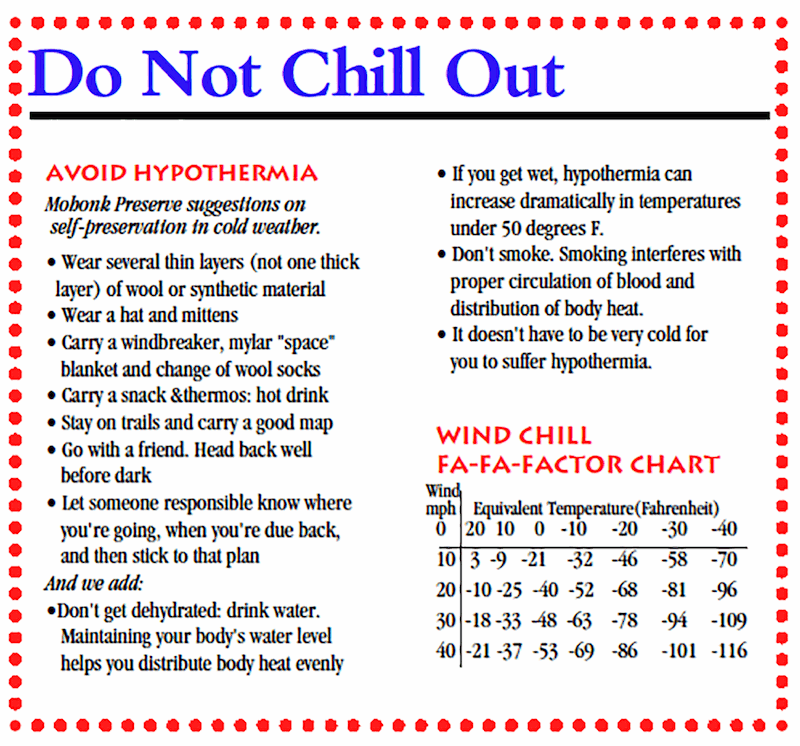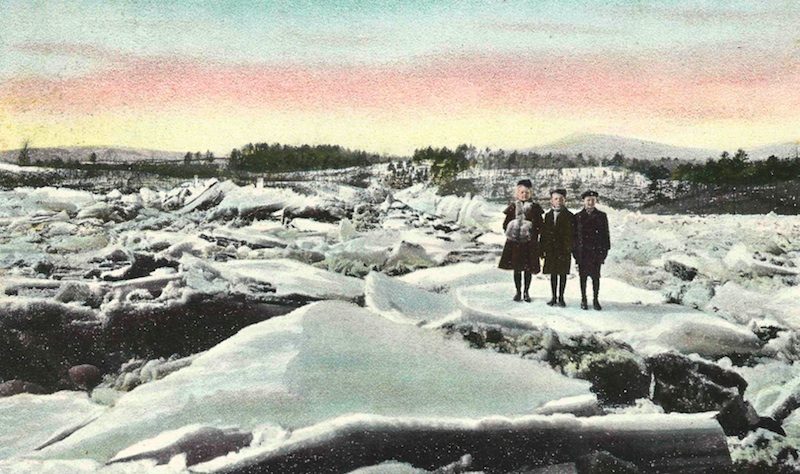
From postcard titled: “Ice Jam on The Esopus Creek, Saugerties, NY”
Winter Tales
Winter 2016
Winter. The thought summons dread to many New Yorkers. To others, it’s the best season–invigorating and challenging. Perspective is often missing in today’s revilers and revelers of winter. We are not that encumbered any more by the season’s bluster. This Winter story begins with entries from a set of diaries begun in 1874 by a young man living in rural Orange County during years when weather dictated much of life–his entries may ameliorate the dread and give real meaning to the challenges of winter. At the bottom of this story is a Wind Chill Factor Chart. You may want to refer to it as you read this story and consider the vintage postcard images that accompany the text.
“John G. Miller of Bullville, Orange County. I am 16 years old on July 26,” reads the fly leaf of John’s 1874 diary. His yearly diaries charted the vagaries of Mother Nature for the next 30 plus years. His simple routine of writing every night gives us insight into life in a farming community at the end of the 18th century and start of the 19th. More importantly, he chronicles the daily influence of weather on his life. Not that he complained. Weather just was. Most of his weather related entries, even in the winter months, begin with the words “Pleasant” or “Clear.”

The 1874 cover and interior cover page from John G. Miller’s diary of that year, and believed to be the first.
The 34 diaries comprising this trove of weather impressions and fascinating tid bits were acquired at an auction in Orange County, and the author of the diaries was born and grew up there. Why the diaries stop at the end of 1908 is unknown and the diary for 1895 is missing. Lack of punctuation, creative spelling, and abbreviations fill the originalpenciled entries. For the sake of clarity, I have added punctuation where it helps clarify an entry.
The 1874 diary begins on Thursday, January 1, with these words posted here exactly as they appear in his neat script: “did not get up till 1/2 Past 7. Pleasant day. to the Store in the morning had my hair cut. Was Riding Hillie. Happy New Year”
From this first entry and others that follow, it appears John first worked in a store where he describes “trade” as poor on January 2nd. “Rainy day–Very warm trade very Poor to day. Made a call in the Evening at Mrs Sauniers.”
In these early diaries weather is described simply as cold, very cold, warm, rainy, pleasant, but no temperatures recorded until later. With his ardent interest in weather, one presumes he had no access to a thermometer.

Ice Mound, Power Station, Napanoch, NY.

Wallkill River Bridge, High Water and ice jam, New Paltz, N.Y. (This Main Street bridge was replaced recently for the third time).

Ice Boating on the Hudson River, N.Y.
‘The three postcards above are all from about 1907–1915.
Jumping ahead fourteen years, John, now around 30 years old, apparently has acquired a thermometer and a family. He recorded for March 4th, “Clear and cold, 8 deg. above zero this morning and the wind blows very hard. The baby does not seem to feel very well today. I do not know but it has taken cold. I am late getting to bed as usual tonight.”
Between the 4th of March and the 10th, he reports the weather continues cold and blustery and he can “…scarcely do anything but the chores now days. I wish I could get a good chunk of a boy to help me. I do not know wether I am going to come across help for this season or not, I hope so. I am late as usual getting to bed tonight.”
On March 10th John writes, “Clear and warm. Today has been a hard day on the (illegible) pa come up today, went with me to Bloomingburgh. I feel sleepy to night”
Sunday, March 11 entry: “Cloudy all day and strong wind a (illegible). It has snowed quite hard. It is likely to be quite a snow storm…” That entry proved prophetic as the Blizzard of 1888 came roaring into the north east.
Monday, March 12 entry:
Oh. Dear. What a day today has been and such a night as tonight. It has been snowing a blowing a hurricane from the north west all day the snow gets in through all the buildings and on the stock. I am sick of such weather. I do hope it will not be so bad tomorrow. Frank G started with milk but did not go far.”
Tuesday, March 13 entry:
Today it is a trifle better than yesterday with but better prospect of its being much better tomorrow. Mr Lucker come over today and I gave him about 15 qts of milk to take home with him. There is no signs of getting my milk off. The snow banks is from 10 to 20 feet high.”
Wednesday, March 14 entry:
It snowed 4 or 5 inches of snow last night and snowed most of the forenoon, but was warmer to day which settled the snow so it could not blow. The wind blows quite hard to night, not very cold. I churned 2 Churnings today, will try and get the milk off tomorrow.”
Thursday, March 15 entry:
“Clear and quite mild. I hired Mr. Lucker today for the remainder of the month. Pay him about 7 dollars. I feel that I need help–this snow has made me so much work. We opened a road through on the hill today and Mr. L took the milk
And of course, every dairy farmer has the same problem. Cows must be milked on schedule, no matter the weather.
In his book, Blizzard: The Great Storm of ‘88, Judd Caplovich tells of a Poughkeepsie farmer’s trial to bring his herd’s milk to market. First, he could not get the milk to a train station because all the roads were blocked. He churned it into butter for his family’s use. Then, when he could get a shipment to a terminal, he learned a train wreck blocked the tracks. It was not until the end of March that he was able to “find a firm market for his farm’s products.”
In the Winter 2010-2011 issue of About Town is another ‘88 story titled “A Conversation With The Quimby Brothers of Marlboro.” The late Howard Quimby related the story of his grandmother’s experience just up the road from Miller’s Bullville. “On March 11, 1888, no one knew that the snow was anything more than a late-season storm. But by March 14th everyone knew it was destined for the record books. It was the ‘Blizzard of ‘88.’
“Phoebe Baxter Quimby of Marlboro was concluding a visit to nearby Plattekill. To make it home, Phoebe’s brothers ended up shoveling a path for her horse and sleigh. They made their way home before the full force of the snow closed down the Northeastern United States.
That blizzard killed more than 400 people (200 in NYC) and cost over 25 million dollars (1.2 billion in current dollars). The losses were mainly from fires no one could reach. Snow totals hit 58” in parts of the Northeast, with wind gusts up to 80 mph. Sustained winds of over 40 mph were reported. Phoebe and her brothers were very lucky.
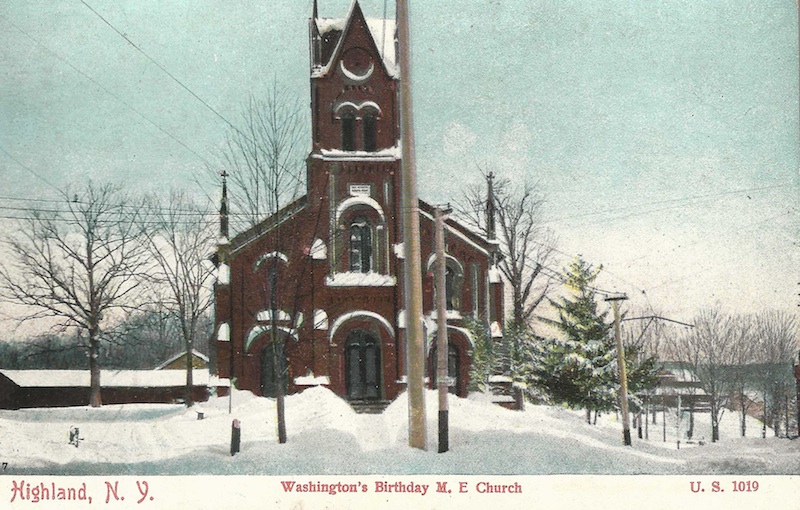
Highland postcard celebrating a snowy Washington’s Birthday. (Postmarked 1910)
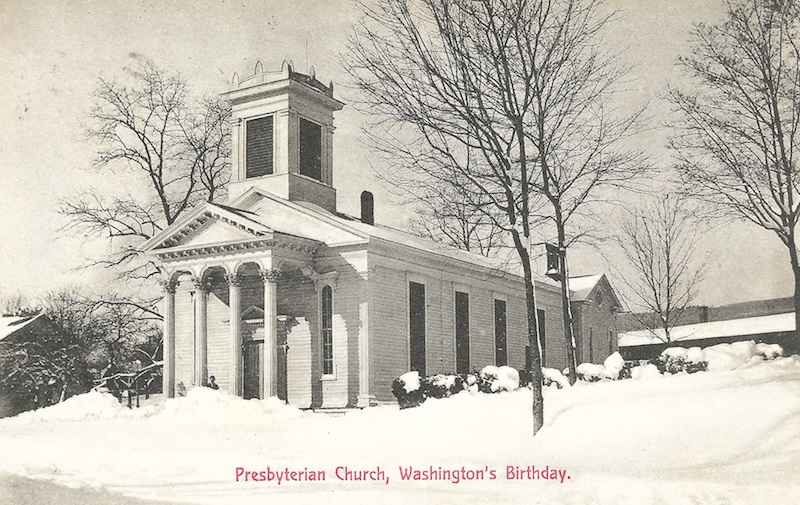
Highland postcard celebrating a snowy Washington’s Birthday. (Postmarked 1916)
Of course, for truly extreme weather we could go back further in Orange and Ulster County history to the great ice ages that covered our region. It is difficult to imagine there could have ever been a mile of ice above us just 10,000 years ago. The evidence can be seen in the “erratics” (huge stones) left along the path of the glacial creep that contradict the native rock, or the striations (deep scratches) left on the Shawangunk Mountains which from Pennsylvania to Rosendale. One of the biggest reminders is Long Island, formed as a terminal moraine where melting ice dropped its accumulated debris at the end of one of the ice ages.
Another reminder that it was once colder here is the number of locally found mastadon remains in Dutchess and Orange County peat bogs.
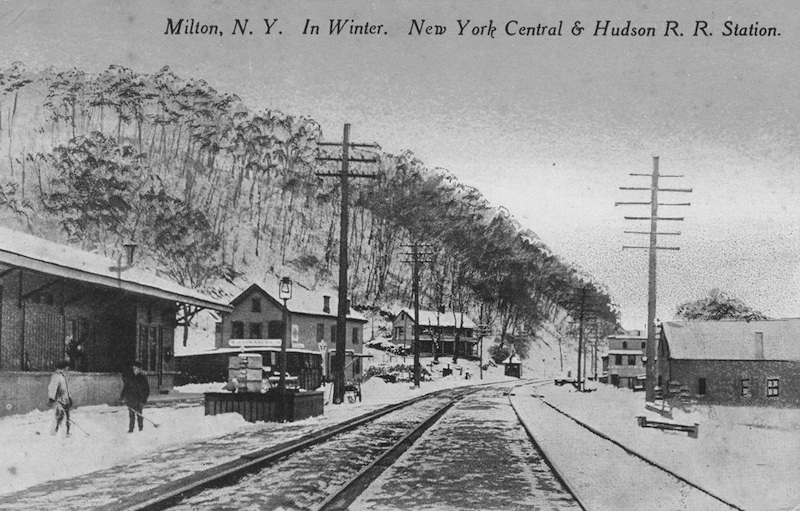
Postcard, “Milton, N.Y. In Winter. New York Central and Hudson R.R. Station,” courtesy of G. Mastropaolo.
John G. Miller would probably have been astounded by what we now know about weather and the processes and things we’ve invented to insulate us from Mother Nature’s cold shoulder. He would no longer lament milk going sour because of snow-blocked roads. He would no longer hand-shovel to reach roads still difficult to navigate. He probably could not imagine plows that clear roads in a matter of hours without so much as a frost-bitten toe. He would most likely consider it a true miracle that cold and snow now signal fun and sport more than endless dangerous freezing work, consuming worry, and frustrating inconvenience.
Let it snow.
* * *

Postcard sent from Highland, NY to Spring Lake, NJ on Nov. 4, 1918. The message on the front: “This is where we live now.” The title of the card is “The Whittley House, Highland, N.Y.” The message on the reverse reads in part, “Anna and I are going South I can’t wait until I go.” This building is gone, but in its life was also a boarding house and a school. It is believed to have housed a crew team for the Intercollegiate Regattas on the Hudson River when the building was a boarding house. (Located in Highland on Grand Street at end of Thorns Lane).
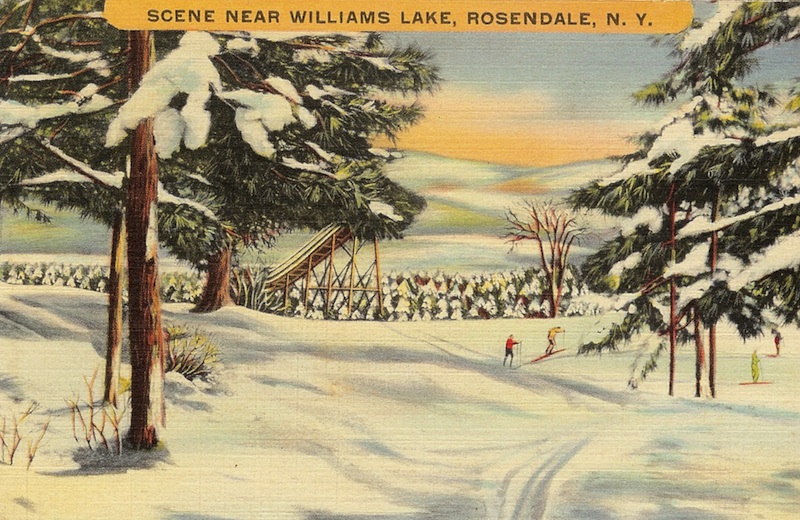
Postcard showing the ski jump, yes, ski jump, near Rosendale Village and Williams Lake.

